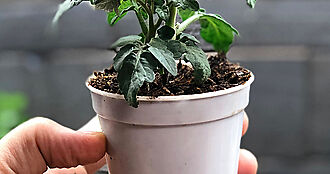Premium Crops Grow Profits
This article was originally published by Greenhouse Management Magazine for their October 2014 issue. Pdf of print article with photos linked below.
Premium crops command premium prices and profits. So why avoid them?
 As the marketplace changes and margins become tighter, this is a good time for growers to move away from commodity products and toward more value-added items that command a better price. Forward- thinking growers are also investing more in proprietary products, such as their own brands, to help differentiate and drive sales.
As the marketplace changes and margins become tighter, this is a good time for growers to move away from commodity products and toward more value-added items that command a better price. Forward- thinking growers are also investing more in proprietary products, such as their own brands, to help differentiate and drive sales.
Yet, many still cling to an outdated production list because it’s what is comfortable and easy to ship, even as profits decline.
Get some perspective
One of the most frustrating things a retailer can hear from a grower is, “We won’t be growing that great new variety because the plugs are too expensive.” Or, “We won’t be growing that outstanding new perennial because it’s too tall.” As a grower, how do you know your retailers won’t be willing to pay premium prices for premium crops? This kind of personal price prejudice can be a serious profit killer. You might not be willing to pay a certain price for a particular product, but your customer might happily pay that price without a second thought.
Before you pass on desirable new varieties, you should first do some research. Surveying your retailers for feedback on your pricing for premium crops could create new opportunities. Often, you can contract-grow premium crops for particular customers even if you’re not ready to add special crops to your availability list. Customers that are shopping garden centers are looking for diversity, quality and purpose. They’re also interested in what’s new and different. The same-old same-old just doesn’t work anymore with most discriminating end-users; be they Boomer gardeners, Gen-X/Y urban farmers or millennial balcony decorators.
Evolve towards profit
While in San Antonio for the 2014 Nursery/Landscape Expo in August, Kristen Kennedy, branch manager for YC Nursery in Texas discussed new varieties and premium crops and whether YC Nursery was moving toward or away from them. “Because our business is not currently focused on retail sales, but rather landscape contractor sales, it can be difficult to grow a lot of higher priced premium crops. Maintenance contacts are tight for many of our landscapers and color change-outs make up a bulk of those contracts. It’s difficult for us to raise our prices for premium crops and still be able to adequately serve the landscape customers, even though the demand for new varieties is high.” Kennedy said they would need to bump new varieties and premium crops out of 4-inch and into quart or larger containers to justify the higher prices.
However, Kennedy did say that they are seeing the container planting trend growing amongst their customers. “What we’ve noticed is that many of our commercial customers are starting to install more container plantings and are reducing larger landscaping beds. So the way that we are having to sell to our clients has changed in that we have to make design suggestions and combination suggestions for container plantings. They are buying more variety and that’s where there could be more opportunity for premium crops. Customers are starting to look for more unique varieties, blooming perennials, and shrubs for specialty containers.”
Upsell opportunities on the rise
As the demand for blooming perennials increases, so do the opportunities to upsell them as premium crops. Lenten rose, Helleborus spp., is a great example: Because supply just hasn’t caught up with demand, some retailers have been pushed to buy plugs and finish their own plants at retail in order to keep customers happy.
The complaints about Lenten rose often raised by growers have to do with the plugs being too expensive and production time too long, so they don’t bother growing them. However, there are garden centers that will pay a premium for a blooming 1- to 2-gallon Lenten rose, especially new varieties. Lenten rose also make outstanding container plants, which makes them a perfect fit for premium container jobs. Many premium perennials and heirlooms fit this same profile.
Plants with purpose profit
What can I do with it? This is the question du jour from new and younger home gardeners. A plant that is just pretty often won’t cut it with many of today’s customers. Edibles are still a growing category and many edibles are becoming more accepted as ornamental plants. Plants that can be used for something, be it cooking, seasoning, cocktails, fragrance or gifting will command a higher price.
Unique and dwarf edibles command some of the highest prices at the garden centers these days. One of my favorite new releases is the Pixie grape developed by Vineland Research and Innovation Centre and Sunrise Greenhouses in Canada. At only 18 inches tall, this tiny wine grape is the ultimate in patio food gardening. Impulse and desire, not budget, will definitely guide customer purchases on these premium crop.
Plants that solve gardening problems, such as limited water, will also be in high demand. Drought and heat tolerance have already become mandatory plant traits for many shoppers in warmer climates. The boom in succulents is due to substance as well as style.
Plants that feed the pollinators are also plants with great purpose. Sure, that salvia is pretty, but that may not be enough for the consumer. But tell that same person that salvia is an important source of food for honey bees, and you may win her over.
Don’t sell yourself short
If you haven’t noticed, big and tall is back in fashion. Therefore, if you’re not putting the new Digiplexis ‘Illumination Flame’ or Digitalis Foxlight ‘Ruby Glow’ into production because you think the plants are too tall, then you may be missing out on a high-margin opportunity – especially if you sell primarily to retailers.
Remember, the retail garden centers are probably more qualified to make end-user pricing decisions, so ask them. Their customers probably won’t worry too much about the price tag when they spot large and impressive specimens of medinilla, Pink Zazzle gomphrena, or T-Rex begonias. Your retailer is most likely going to be just fine paying you a higher price to get high-demand plants in stock. They’ll get their margin, and so will you.
Size up your plants
Still afraid of those high plug prices? Bumping premium bedding or perennial crops to larger container sizes can be a great way to soften the blow and present a product with high perceived value. The prices on grafted tomato plugs could be cost prohibitive when grown in a 4-inch pot. However, produce these in-demand varieties in quarts or gallons and you and your retailers will be able to command a premium price.
Conversely, re-purposing blooming shrubs as container plants is a good way to create a premium crop out of what once may have been a commodity. By producing small-growing or dwarf shrubs in smaller containers, they can be more easily tucked into container displays, while still providing instant impact.
Perception of value is everything
Your customer can only value your product as much as you do. While it’s logical as growers to operate in a “production & shipping” mentality, we’re at a point in our industry where the end-user deserves and requires more consideration. Growers that cater to the end consumer by being thoughtful about their needs and how plants are used will score big points and better profits.
Leslie F. Halleck is a consultant and contributing editor for the GIE Media Horticulture Group and owner of Halleck Horticultural, LLC, through which she provides horticultural content marketing, social media management, and strategy consulting for green industry businesses. www.lesliehalleck.com



